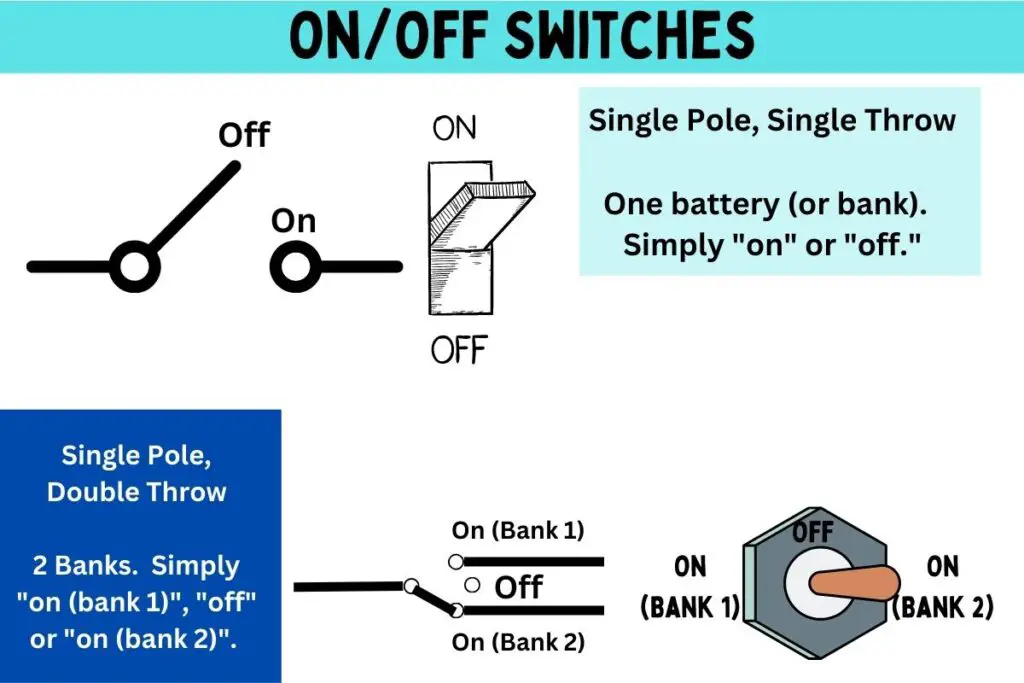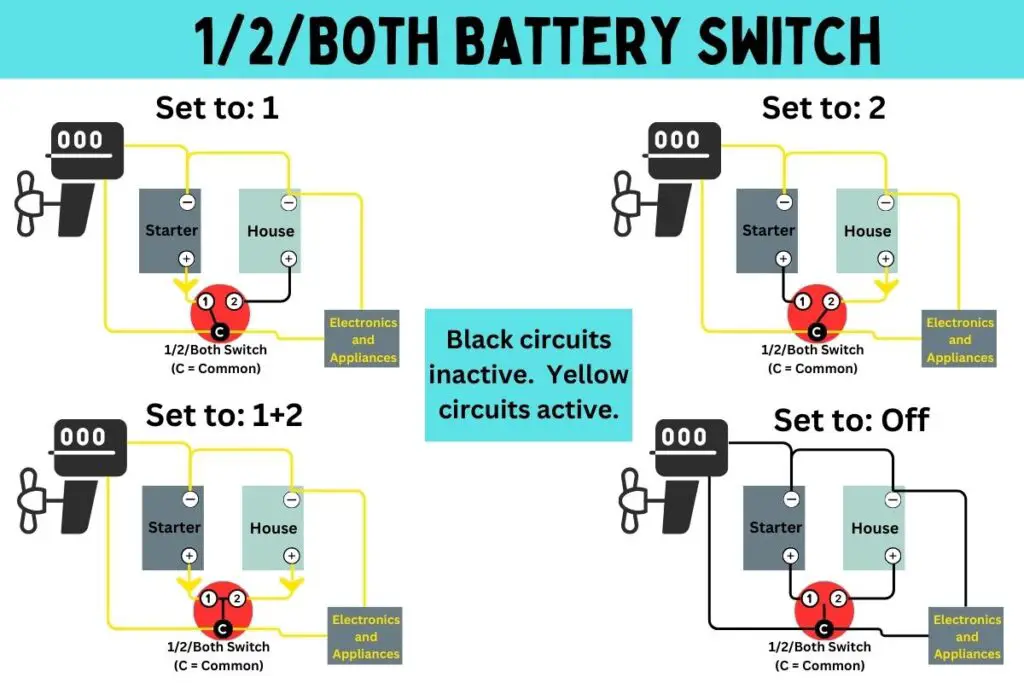A boat battery switch is a crucial component of a boat’s electrical system. It’s responsible for managing power from multiple battery banks, ensuring that essential systems continue to run while protecting your batteries from over-discharge or damage.
In this quick article we’ll explore the function of boat battery switches by focusing on the simple on/off switch, the intelligent battery switch, and the traditional on/off/1/1+2 (both) battery switch.
Hopefully, by the end you’ll have a firm grasp on the different types of boat battery switches and the pros and cons of each.

Simple On/Off Switch
The simplest form of a boat battery switch is the on/off switch. These switches typically come in either single pole, single throw (SPST) or single pole, double throw (SPDT) configurations. SPST switches have two positions: on and off. SPDT switches also have three positions (on for bank 1, off, on for bank 2), but they can control two separate battery banks or devices. SPDT switches can only either turn on bank 1 or bank 2 — not both simultaneously.
In the on position, the switch connects the battery to the boat’s electrical system, providing power to all devices and systems. When the switch is turned off, it disconnects the battery from the electrical system, cutting off the power supply. This switch is useful for boats with a single battery or those that require a simple method to disconnect the battery during storage or maintenance.

Intelligent Battery Switch
An intelligent battery switch, also known as an automatic charging relay (ACR) or voltage sensitive relay (VSR), is a more advanced solution for managing multiple battery banks. It automatically combines and isolates battery banks based on voltage levels, ensuring that the batteries are charged efficiently and effectively while at the same time preventing over-discharge.
The intelligent battery switch monitors the voltage levels of the connected batteries. When it detects that a charging source (such as an alternator or battery charger) is present, and one battery bank reaches a predetermined voltage (typically 13.3-13.7 volts), the switch combines the battery banks, allowing them to be charged simultaneously.
Once the charging source is removed or the voltage drops below a set threshold, the switch isolates the battery banks, ensuring that they don’t both discharge. This process is automatic and requires no user intervention, making it a convenient option for boaters who want a hassle-free solution for managing their batteries.
In simpler terms, an intelligent battery switch (ACR or VSR) allows both of your battery banks to charge simultaneously when there’s a charging source, but will separate the banks and only allow your boat to draw from house battery when there is no charging source available and will save your starter battery for starting the engine.
The intelligent battery switch will detect a charging source that is providing current to the starter battery. When the starter battery voltage reaches 13.3-13.7 volts, the intelligent battery switch will close and allow both battery banks (starter and house) to receive some of that charge.
As soon as the charging source stops (engine off or charger disconnected) and the starter battery drops to 12.8-volts, the intelligent battery switch will open and not allow the boat’s electronics to pull any further current from the starter battery and will only draw from the house battery, thus ensuring that you’ll always be able to start your engine.

Traditional “1/2/Both” Battery Switch
The traditional “1/2/Both” battery switch, also known as a selector switch or four-position switch, is a popular choice for managing multiple battery banks in a boat’s electrical system. The switch has four positions: off, 1, 2, and 1+2 (both). This setup allows you to choose between different battery banks or combine them when needed.
Here’s a brief explanation of each position:
- Off: The switch disconnects all battery banks from the boat’s electrical system. This position is useful when performing maintenance or storing the boat.
- 1: The switch connects battery bank 1 to the electrical system, providing power to devices and systems while leaving battery bank 2 disconnected. Bank 1 is usually the starter battery for the boat engine.
- 2: The switch connects battery bank 2 to the electrical system, providing power while leaving battery bank 1 disconnected. Bank 2 is usually the house battery for powering all of your electronics and accessories
- 1+2 (Both): The switch connects both battery banks to the electrical system, either to provide additional power or charge both batteries simultaneously. This switch setting is helpful if your battery banks are both depleted and you need to ensure that you’ll be able to draw from both battery banks to start your boat’s engine. It draws from them both in parallel.
This type of battery switch is ideal for boats with multiple battery banks, as it provides manual control over which bank is connected to the electrical system. It also offers a level of redundancy, as you can switch between battery banks if one becomes depleted or fails.
Installation and Maintenance Tips
Regardless of the type of battery switch you choose, proper installation and maintenance are essential for optimal performance and safety. Here are some tips to keep in mind:
- Install the battery switch in a location that’s easily accessible, dry, and well-ventilated to ensure proper operation and prevent overheating.
- Use marine-grade components, such as tinned copper wire and corrosion-resistant terminals, to minimize the risk of electrical issues and prolong the life of your boat’s electrical system.
- Securely mount the battery switch to a stable surface to prevent vibrations and movement during operation.
- Regularly inspect the switch, wiring, and connections for signs of wear, corrosion, or damage, and address any issues promptly.
- Perform routine maintenance on your batteries, such as cleaning the terminals and checking the electrolyte levels, to ensure they remain in good working condition.
Final Takeaways
Boat battery switches play a vital role in managing the power supply and battery banks on your vessel. Understanding the function and differences between the simple on/off switch, intelligent battery switch, and traditional “1/2/Both” battery switch will help you make an informed decision when selecting the right switch for your boat.
Proper installation, maintenance, and usage of these switches will ensure a reliable and efficient electrical system, enhancing the safety and performance of your boat.
